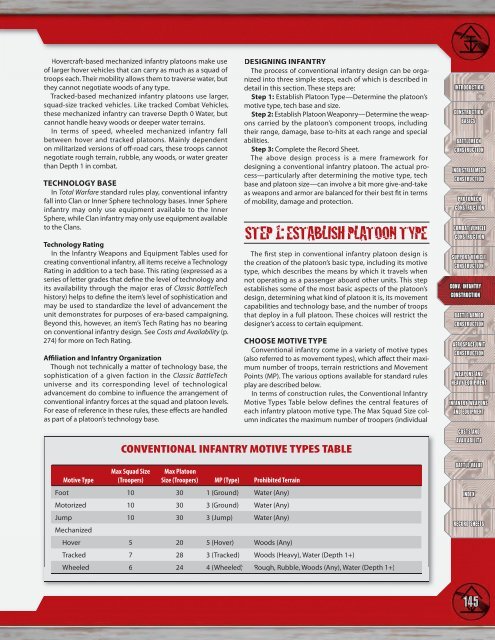the shape of things to come
the shape of things to come
the shape of things to come
You also want an ePaper? Increase the reach of your titles
YUMPU automatically turns print PDFs into web optimized ePapers that Google loves.
Hovercraft-based mechanized infantry pla<strong>to</strong>ons make use<br />
<strong>of</strong> larger hover vehicles that can carry as much as a squad <strong>of</strong><br />
troops each. Their mobility allows <strong>the</strong>m <strong>to</strong> traverse water, but<br />
<strong>the</strong>y cannot negotiate woods <strong>of</strong> any type.<br />
Tracked-based mechanized infantry pla<strong>to</strong>ons use larger,<br />
squad-size tracked vehicles. Like tracked Combat Vehicles,<br />
<strong>the</strong>se mechanized infantry can traverse Depth 0 Water, but<br />
cannot handle heavy woods or deeper water terrains.<br />
In terms <strong>of</strong> speed, wheeled mechanized infantry fall<br />
between hover and tracked pla<strong>to</strong>ons. Mainly dependent<br />
on militarized versions <strong>of</strong> <strong>of</strong>f -road cars, <strong>the</strong>se troops cannot<br />
negotiate rough terrain, rubble, any woods, or water greater<br />
than Depth 1 in combat.<br />
TECHNOLOGY BASE<br />
In Total Warfare standard rules play, conventional infantry<br />
fall in<strong>to</strong> Clan or Inner Sphere technology bases. Inner Sphere<br />
infantry may only use equipment available <strong>to</strong> <strong>the</strong> Inner<br />
Sphere, while Clan infantry may only use equipment available<br />
<strong>to</strong> <strong>the</strong> Clans.<br />
Technology Rating<br />
In <strong>the</strong> Infantry Weapons and Equipment Tables used for<br />
creating conventional infantry, all items receive a Technology<br />
Rating in addition <strong>to</strong> a tech base. This rating (expressed as a<br />
series <strong>of</strong> letter grades that defi ne <strong>the</strong> level <strong>of</strong> technology and<br />
its availability through <strong>the</strong> major eras <strong>of</strong> Classic BattleTech<br />
his<strong>to</strong>ry) helps <strong>to</strong> defi ne <strong>the</strong> item’s level <strong>of</strong> sophistication and<br />
may be used <strong>to</strong> standardize <strong>the</strong> level <strong>of</strong> advancement <strong>the</strong><br />
unit demonstrates for purposes <strong>of</strong> era-based campaigning.<br />
Beyond this, however, an item’s Tech Rating has no bearing<br />
on conventional infantry design. See Costs and Availability (p.<br />
274) for more on Tech Rating.<br />
Affi liation and Infantry Organization<br />
Though not technically a matter <strong>of</strong> technology base, <strong>the</strong><br />
sophistication <strong>of</strong> a given faction in <strong>the</strong> Classic BattleTech<br />
universe and its corresponding level <strong>of</strong> technological<br />
advancement do combine <strong>to</strong> infl uence <strong>the</strong> arrangement <strong>of</strong><br />
conventional infantry forces at <strong>the</strong> squad and pla<strong>to</strong>on levels.<br />
For ease <strong>of</strong> reference in <strong>the</strong>se rules, <strong>the</strong>se eff ects are handled<br />
as part <strong>of</strong> a pla<strong>to</strong>on’s technology base.<br />
Motive Type<br />
DESIGNING INFANTRY<br />
The process <strong>of</strong> conventional infantry design can be organized<br />
in<strong>to</strong> three simple steps, each <strong>of</strong> which is described in<br />
detail in this section. These steps are:<br />
Step 1: Establish Pla<strong>to</strong>on Type—Determine <strong>the</strong> pla<strong>to</strong>on’s<br />
motive type, tech base and size.<br />
Step 2: Establish Pla<strong>to</strong>on Weaponry—Determine <strong>the</strong> weapons<br />
carried by <strong>the</strong> pla<strong>to</strong>on’s component troops, including<br />
<strong>the</strong>ir range, damage, base <strong>to</strong>-hits at each range and special<br />
abilities.<br />
Step 3: Complete <strong>the</strong> Record Sheet.<br />
The above design process is a mere framework for<br />
designing a conventional infantry pla<strong>to</strong>on. The actual process—particularly<br />
after determining <strong>the</strong> motive type, tech<br />
base and pla<strong>to</strong>on size—can involve a bit more give-and-take<br />
as weapons and armor are balanced for <strong>the</strong>ir best fi t in terms<br />
<strong>of</strong> mobility, damage and protection.<br />
STEP 1: ESTABLISH PLATOON TYPE<br />
The fi rst step in conventional infantry pla<strong>to</strong>on design is<br />
<strong>the</strong> creation <strong>of</strong> <strong>the</strong> pla<strong>to</strong>on’s basic type, including its motive<br />
type, which describes <strong>the</strong> means by which it travels when<br />
not operating as a passenger aboard o<strong>the</strong>r units. This step<br />
establishes some <strong>of</strong> <strong>the</strong> most basic aspects <strong>of</strong> <strong>the</strong> pla<strong>to</strong>on’s<br />
design, determining what kind <strong>of</strong> pla<strong>to</strong>on it is, its movement<br />
capabilities and technology base, and <strong>the</strong> number <strong>of</strong> troops<br />
that deploy in a full pla<strong>to</strong>on. These choices will restrict <strong>the</strong><br />
designer’s access <strong>to</strong> certain equipment.<br />
CHOOSE MOTIVE TYPE<br />
Conventional infantry <strong>come</strong> in a variety <strong>of</strong> motive types<br />
(also referred <strong>to</strong> as movement types), which aff ect <strong>the</strong>ir maximum<br />
number <strong>of</strong> troops, terrain restrictions and Movement<br />
Points (MP). The various options available for standard rules<br />
play are described below.<br />
In terms <strong>of</strong> construction rules, <strong>the</strong> Conventional Infantry<br />
Motive Types Table below defines <strong>the</strong> central features <strong>of</strong><br />
each infantry pla<strong>to</strong>on motive type. The Max Squad Size column<br />
indicates <strong>the</strong> maximum number <strong>of</strong> troopers (individual<br />
CONVENTIONAL INFANTRY MOTIVE TYPES TABLE<br />
Max Squad Size<br />
(Troopers)<br />
Max Pla<strong>to</strong>on<br />
Size (Troopers) MP (Type) Prohibited Terrain<br />
Foot 10 30 1 (Ground) Water (Any)<br />
Mo<strong>to</strong>rized 10 30 3 (Ground) Water (Any)<br />
Jump<br />
Mechanized<br />
10 30 3 (Jump) Water (Any)<br />
Hover 5 20 5 (Hover) Woods (Any)<br />
Tracked 7 28 3 (Tracked) Woods (Heavy), Water (Depth 1+)<br />
Wheeled 6 24 4 (Wheeled) Rough, Rubble, Woods (Any), Water (Depth 1+)<br />
INTRODUCTION<br />
CONSTRUCTION<br />
BASICS<br />
BATTLEMECH<br />
CONSTRUCTION<br />
INDUSTRIALMECH<br />
CONSTRUCTION<br />
PROTOMECH<br />
CONSTRUCTION<br />
COMBAT VEHICLE<br />
CONSTRUCTION<br />
SUPPORT VEHICLE<br />
CONSTRUCTION<br />
CONV. INFANTRY<br />
CONSTRUCTION<br />
BATTLE ARMOR<br />
CONSTRUCTION<br />
AEROSPACE UNIT<br />
CONSTRUCTION<br />
WEAPONS AND<br />
HEAVY EQUIPMENT<br />
INFANTRY WEAPONS<br />
AND EQUIPMENT<br />
COSTS AND<br />
AVAILABILITY<br />
BATTLE VALUE<br />
INDEX<br />
RECORD SHEETS<br />
145


